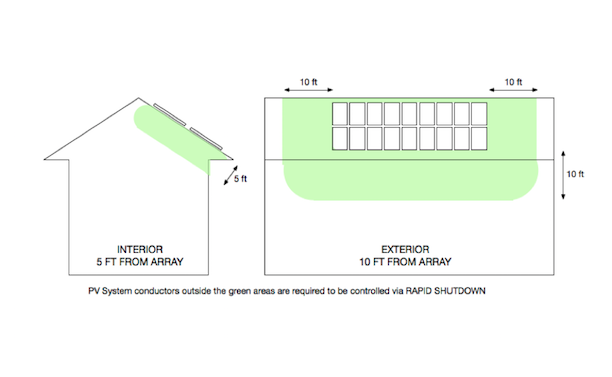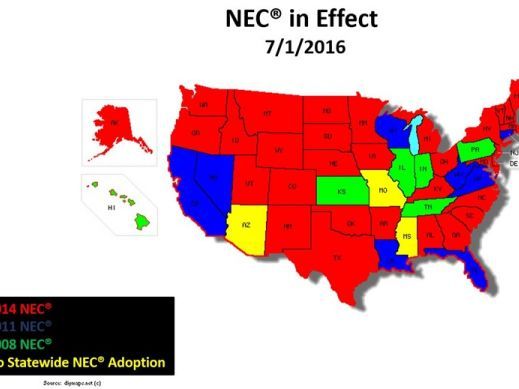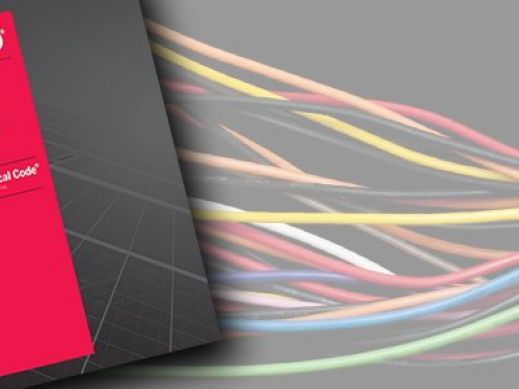
On January 1st, 2017 California will adopt NEC 2014 and by the end of 2017 most states will have adopted this code. Within this code cycle is the famous NEC 690.12, Rapid Shutdown of PV Systems on Buildings. The following will explore applying rapid shutdown (RS) to residential buildings with 15kW or less grid-tied-only PV systems by describing the requirements of NEC 690.12 and presenting equipment options to achieve these requirements. Installers must fully understand this code and know how to comply with it to avoid additional costs or delayed projects. Please note, commercial systems and systems with battery backup are not explored at this time.
Installers within jurisdictions that adopted NEC 2014 out of the gate were presented with difficulty in achieving the goals of RS using string inverters. This stemmed mainly from two conditions. First, lack of knowledge of RS and second, lack of a pre-packaged solution. In terms of knowledge, Rapid Shutdown was a new concept that presented additional design criteria that both system integrators and AHJs had to work together to determine a solution that met both the code requirements and local conditions. With the absence of pre-packaged systems, system integrators were left on their own to put together listed components that would achieve the requirements of RS.
Now to the code. 690.12 requires RS to be installed with PV system circuits that are installed on or in buildings.
690.12(1) states that the requirements of RS apply to PV system conductors that are:
- more than 1.5m (5ft) in length inside a building
- more than 3m (10 ft) from a PV array
The following diagram presents these two dimensional requirements

Therefore, any PV system conductors more than 10 feet away from the array on the exterior of the building or more than 5 feet in length within a building must be controlled via RS.
690.12(2) states that the controlled conductors must be limited to 30V and 240V•A within 10 seconds of RS initiation. This requirement sets the potential threshold of PV circuits while at the same time allowing for 24V control circuits.
690.12(3) states that the requirements presented in 690.12(2) must be met when voltage and power are measured between any two PV system conductors as well as between any conductor and ground. This ensures that the voltage and power limits are met for the entire circuit.
690.12(4) states that the RS initiation methods must be labeled according to 690.56(B) which states that buildings with a PV system must have a permanent plaque or directory installed on the exterior of the building in a readily accessible location that states the location of the service disconnecting means as well as the PV system disconnecting means if both disconnecting means are not located at the same location. This requirement calls for system integrators to include direction to emergency personnel, first responders and others for initiating RS.
690.12(5) states that the equipment used for RS must be listed and identified. The requirement does not state that the equipment must be listed and identified specifically for PV system rapid shutdown. This allows system designers and integrators to utilize listed equipment that can perform the duties of RS, such as DC-rated contactors, string inverters, micro inverters and power optimizers just to name a few.
So, how does one achieve rapid shutdown? There are numerous methods now that the code has been around for a couple of years. The following is a short list of methods to achieve RS depending on the overall system design:
- String Inverter
- Place the inverter within the 10ft (exterior) or 5ft (interior) perimeter of the PV array
- Install a listed DC contactor with control circuit to de-energize PV system conductors outside the allowable perimeter. Options include
- Midnite Solar and SolarBos have a couple solutions depending on the design.
- Manufacturer provided RS solution: Yaskawa - Solectria Solar, Fronius, and SMA.
- Now SolarEdge inverters have Rapid shutdown functionality; no additional equipment required
- Innovative Solar Inc has a capacitor discharge solution. This solution is available with the popular SolaDeck enclosure and is available with all inverters.
- Other DC optimizers such as Tigo have RSD solutions.
- Micro Inverter / AC-Module
- PV system conductors away from the array will be de-energized when power is removed from the building. It is important to describe the initiation of rapid shutdown on your permanent plaque or directory
- Finally, if it is foreseeable that an issue might arise with the local AHJ, it is always best to start up a discussion with the AHJ to work out a solution.
Rapid Shutdown is meant to provide a safer working environment for maintenance crew, first responders and emergency personnel especially in the case of an emergency. RS achieves this by requiring PV system conductors that are a certain distance away from the PV array(s) to be de-energized to what is considered a safe level. This is a very good step forward in making PV systems safer for the PV industry, emergency personnel and PV system adopters.


